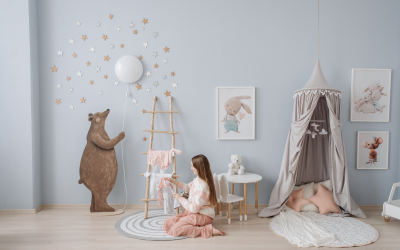A newborn wake window is the period of time your baby is awake between naps. I like to count the number of wake windows that occur between the moment you take your kid out of his crib or cot and the time you lay him down again.
Wake windows encompass everything that happens when your baby is out of the bassinet or crib, such as eating, playing with toys, singing songs, reading books, and even the nighttime routine.
WHAT IS THE SIGNIFICANCE OF NEWBORN WAKE WINDOW?
Overly long newborn wake windows can result in an overtired baby who struggles to settle down enough to fall or remain asleep. Wake windows that are too short, on the other hand, can result in a baby who is simply not ready to sleep or will only take a brief catnap. If you get the wake windows just perfect, your baby will be able to go asleep more easily and stay asleep for longer.
HOW CAN I DETERMINE THE BEST WAKING TIMES FOR MY BABY?
Your goal is to strike the right balance between being tired enough to sleep and not being excessively fatigued. So, let’s figure out how much awake time your baby requires in between naps:
- Begin with the wake window range indicated for your baby’s age
- Pay attention! Keep an eye on the length and quality of your baby’s naps, as well as how she behaves! Remember, you know your baby best, so keep an eye on her. If she’s fussy and struggling, aim for the shorter end of the wake window range. Aim toward the longer end of the range if she’s aware and active.
REMEMBER: Your baby is rapidly growing and developing. Every month, you should reassess baby’s waking times!
Combining your knowledge of your newborn wake windows with their specific cues will assist you in creating a flexible routine for your day.
HOW CAN I KNOW IF THE WAKE WINDOWS ARE CORRECT?
Excellent question! Finding the best wake windows for your infant may need some trial and error. When naps and bedtime are no longer a conflict and your Baby sleeps for long periods of time, you know you’ve got it right. Do you want to see some examples of how this can work? More information on normal sleep schedules for your baby’s age can be found on my blog, Nap Schedules: 5 Months to 25 Months.
If your newborn wake windows appear to be correct, but sleep is still a problem, I can help! Here you find a step-by-step method for teaching your newborn the necessary sleep skills.
WHY ARE NEWBORN WAKE WINDOWS USED AT ALL?
The early days of sleep training were mainly about sticking to a strict regimen. Your child should wake up at a certain time, eat at a certain time, and sleep at a certain time. If your child did not fit into this timetable, you were doing it incorrectly.
As a result, some parents forced their child to follow a schedule that did not correspond to what the child actually need. This resulted in very exhausted infants and toddlers!
Wake windows understand that neonates, infants, and toddlers have unique sleeping habits and sleep requirements. Some infants require more sleep than others. The wake windows give parents some basic recommendations for where to start, but they are not hard and fast laws.
You might have a baby who is an early riser, for example. They might get up at 6 a.m. every day. If you follow a strict schedule, it may state that they should get up at 7 a.m. and take a nap at 9 a.m. You’ll have a very grumpy, overtired infant on your hands if you try to keep them awake till 9 a.m.
However, if you follow the newborn wake windows, you’ll know that your 5-month-old should be awake for roughly 2 hours, therefore nap time should be about 8 a.m., not 9:00 a.m.
On the other hand, if you have a child that requires less sleep, a timetable may try to force them to take a nap before they’re ready. That makes for a long story.
HOW TO USE NEWBORN WAKE WINDOWS?
When working with newborn wake windows, keep in mind that they are only guidelines. It’s pointless to treat this chart as if it were written in stone. Every youngster has unique requirements. Some people benefit from a shorter wake window, while others benefit from staying awake for a longer period of time.
The ages listed can also differ slightly. Your youngster may perform better in terms of staying awake longer before their age corresponds to the chart. And some children may complete the 3-2 nap transition later than others.
You are the one who knows your child best, so you must plan for what your youngster requires. And, because newborn wake windows are customizable, you can always be flexible.
Many children’s sleep requirements change during the day. I normally recommend shorter wake windows in the morning and longer wake windows before going to bed. Others need a shorter wake window in the late afternoon or evening, since they are more alert in the morning.
Because this is life, there will be occasions when your infant falls asleep or wakes up too early. Don’t be concerned! You did not injure the child. If your snooze is too brief, shorten your next wake window. If your newborn appears to be overtired, you should absolutely alter the wake window. Over tiredness can result in short naps, resulting in a very tired and frequently cranky child. Keep an eye out for warning indicators and adjust accordingly.
Finally, make sure you’re not continuously tweaking things. That may appear to contradict what I just said, but it does not. While there will be some trial and error in determining the best wake windows for your child, don’t expect to know whether the changes are necessary or working right away.
Just because it took your infant 20 minutes to fall asleep this morning doesn’t mean they’re ready for lengthier wake windows.
If they’ve been taking longer to fall asleep at all of their naps for a few days, you could try adjusting it.
ADJUSTING WAKE WINDOWS RULES
Here are the rules that I use with my customers to assist you figure out what your newborn wake window is. I begin with the time shown in the chart above for the child’s age. I then make recommendations based on parent feedback in order to create a more “by the clock” (BTC) plan.
- If something isn’t broken, don’t fix it.
- If a sleep lasts 20-30 minutes, they’re overtired, and you should try cutting back on the awake time by 15 minutes.
- If they take a 45-minute nap, they are under-tired, and you should increase their awake time by 15 minutes.
- If a nap time that was previously working (nice nap, pleasant, going down easy) is no longer working, add 15 minutes of awake time.
- If they wake up 45 minutes after bedtime, subtract 15 minutes from their awake time before bed.
- Add 15 minutes of awake time if they take longer than 15 minutes to fall asleep.
- If they are extremely grumpy and fussy when they wake up, reduce their awake time by 15 minutes.
That’s all.
You’re ready to identify your newborn wake windows and build a plan for them now that you understand what they are and why we use them!
FAQ.
DO NEWBORNS NEED WAKE WINDOWS
The concept of “newborn wake windows” and toddler sleep is becoming increasingly popular. In a word, “wake windows” are periods of time between sleeps. They’re also referred to as “awake windows” or “infant wake windows.” Despite their scientific foundation, there is scant evidence that systems based on wake windows benefit newborn and toddler naps. They also appear to be unnecessarily convoluted to me. However, some parents swear by them. So let’s dig a little deeper.
Is Feeding Included in Wake Windows?
Yes! The wake window is the span of time between when your baby wakes up from one nap and when they go down for their next sleep. Because your baby is awake while feeding, that time is included in his wake window.
Feeding will take up the majority of your newborn wake windows at first. Your baby’s wake window will expand as he or she grows, is able to stay awake longer, and is more efficient at feedings.
WHEN SHOULD I START USING A WAKE WINDOW
In general, most babies have a certain amount of time they can stay awake before becoming exhausted. Some babies require more wake time, while others require less wake time.
Here are the wake window ranges for newborns to two years old.
Are You Keeping Your Baby Awake Too Long?
One of the most widely held beliefs about babies is that “babies sleep when they are exhausted.” Life would be easier if it were true, but it isn’t. Helping your baby fall asleep, determining when they need to sleep, and ensuring they receive enough sleep is every new parent’s nightmare. But if you have figured out once, what you need to do, then life becomes much easier.
How long should a one-week-old baby sleep?
Image result for how long is a 1-week old’s wake window What should I do with my two-week-old when he is awake? How long do two-week-old stay awake?
In between sleep periods, your infant will most likely have wake times ranging from 30 to 90 minutes. Newborn wake windows are often shorter in the morning and grow longer throughout the day. Expect your infant to be awake for a longer period of time (but no more than 90 minutes) before going to bed.
How to Extend Wake Windows?
Some babies will begin to show tired cues early in their wake window, leading you to believe they need a nap before they actually do. This was a common occurrence with my daughter!
She would yawn at the 60-minute mark when she was about 11 weeks old, but after trial and error, I realized she required a little more time to take a deep and restorative nap.
This is the best analogy I can think of. If your child is hungry at 4:30 p.m. but dinner is not ready until 5:00 p.m. You don’t want to give your kid a snack right now since it will prevent them from eating dinner.
Instead, you want to ensure that they are sufficiently hungry to sit down and have dinner with the family.
Baby’s sleep wake windows are comparable!
If your child has autonomous sleeping patterns but still struggles with short naps. Think about their wake window. You may need to stretch them a little to keep them awake for a little longer.
Going outside or changing the surroundings on your infant is an excellent method to extend their wake time. A little sunshine and fresh air usually helps them get over the hump they need to get to the new wake time.
You can also try enlisting the help of a big brother or sister or the family dog to distract your infant and keep them awake for an extra 15 minutes.
SCHEDULE VS. WAKE WINDOWS
When your newborn is 6 to 9 months old, you can transition from observing wake windows each day to a more consistent sleep routine.
With a two-nap routine, your newborn will sleep for around 2.5 to 3.5 hours after waking up. You’ll create a 6-month-old routine that works for your baby and keep naps and bedtime consistent throughout the day.
You won’t need to change your baby’s naps or bedtime dependent on when they got up from their various naps because you’ll utilize the age appropriate wake window to determine their schedule.
Regardless of your baby’s naps that day, nap and bedtime will be the same every day, which helps regulate your baby’s schedule and prepares him for sleep. It also allows you to organize your day much more predictably because you know when baby’s naps will be each day!
If you’re having trouble with newborn wake windows, my baby sleep cheat sheets include baby wake windows and sample schedules for ages newborn through three years old, as well as nap plans for each age.






